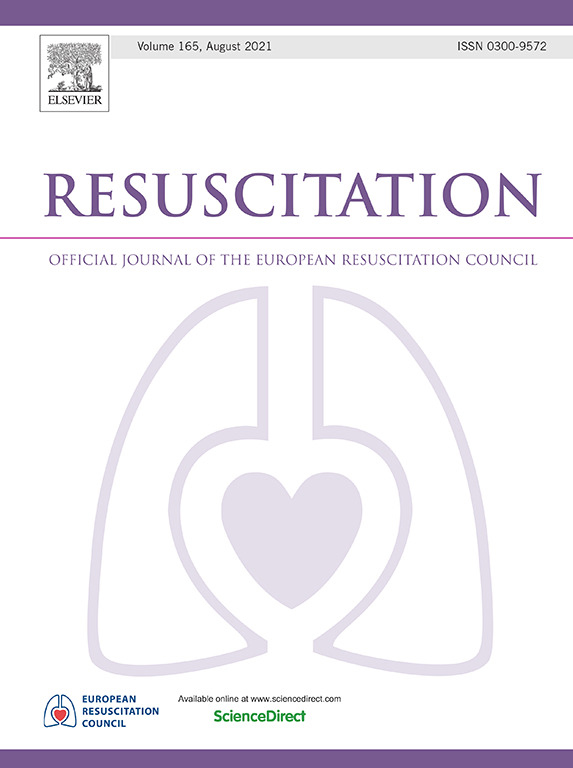复苏时间对院外心脏骤停后12个月功能恢复的影响。
IF 4.6
1区 医学
Q1 CRITICAL CARE MEDICINE
引用次数: 0
摘要
目的:探讨心肺复苏(CPR)时间对院外心脏骤停(OHCA)患者12个月功能恢复和健康相关生活质量(HRQoL)结果的影响。方法:我们对2015年至2024年期间接受紧急医疗服务(EMS)尝试复苏并出现最初休克节奏的成年人(年龄≥18岁)进行回顾性分析。我们排除了儿科病例,创伤病因和EMS目击的OHCA。幸存者在心脏骤停12个月后出院,根据格拉斯哥结局量表评估功能恢复情况。心肺复苏持续时间定义为EMS累计复苏时间,直至恢复自主循环或复苏终止。结果:在7,922例最初有震荡性心律的OHCA中,有6,371例符合纳入标准。2054例(32.6%)患者存活至出院。其中,1769例(86.1%)患者在12个月时确认存活,1429例患者对随访有反应。存活至12个月且功能恢复良好的患者CPR持续时间的第50、90和99百分位数分别为8分钟、25分钟和69分钟。在所有最初有休克节律的患者中,CPR持续时间每增加一分钟与12个月良好功能恢复的风险调整后几率降低(AOR=0.905, 95%CI 0.899-0.911)和HRQoL相关。仅在12个月应答者中,CPR持续时间的增加与较低的良好恢复几率(AOR=0.989, 95%CI 0.980-0.998)和无护理在家生活相关。结论:在最初具有震荡性心律的OHCA中,增加CPR持续时间与较差的长期功能恢复和生活质量相关。本文章由计算机程序翻译,如有差异,请以英文原文为准。
Impact of resuscitation duration on 12-month functional recovery following out-of-hospital cardiac arrest with initially shockable rhythms
Aim
To describe the impact of cardiopulmonary resuscitation (CPR) duration on the 12-month functional recovery and health-related quality of life (HRQoL) outcomes of out-of-hospital cardiac arrest (OHCA) patients with initially shockable rhythms.
Methods
We performed a retrospective analysis of adults (aged ≥18 years) who had an emergency medical service (EMS) attempted resuscitation with an initially shockable rhythm between 2015 and 2024. We excluded paediatric cases, traumatic aetiology and EMS witnessed OHCA. Survivors to hospital discharge were followed up 12 months post-arrest to assess functional recovery according to the Glasgow Outcome Scale-Extended. CPR duration was defined as the total cumulative EMS resuscitation time until either return of spontaneous circulation or resuscitation termination.
Results
Of the 7922 OHCA with an initially shockable rhythm, 6371 met the inclusion criteria. 2054 (32.6 %) patients survived to hospital discharge. Of those, 1769 (86.1 %) patients were confirmed alive at 12-months, and 1429 responded to follow-up. The 50th, 90th, and 99th percentiles of CPR duration for those who survived to 12 months with favourable functional recovery were 8, 25, and 69 min, respectively. Among all patients with initially shockable rhythms, each minute increase in CPR duration was associated with reduced risk-adjusted odds of 12-month favourable functional recovery (AOR = 0.905, 95 %CI 0.899–0.911) and HRQoL. Among 12-month responders only, increasing CPR duration was associated with lower odds of favourable recovery (AOR = 0.989, 95 %CI 0.980–0.998) and living at home without care.
Conclusion
In OHCA with an initially shockable rhythm, increasing CPR duration is associated with poorer long-term functional recovery and quality-of-life.
求助全文
通过发布文献求助,成功后即可免费获取论文全文。
去求助
来源期刊

Resuscitation
医学-急救医学
CiteScore
12.00
自引率
18.50%
发文量
556
审稿时长
21 days
期刊介绍:
Resuscitation is a monthly international and interdisciplinary medical journal. The papers published deal with the aetiology, pathophysiology and prevention of cardiac arrest, resuscitation training, clinical resuscitation, and experimental resuscitation research, although papers relating to animal studies will be published only if they are of exceptional interest and related directly to clinical cardiopulmonary resuscitation. Papers relating to trauma are published occasionally but the majority of these concern traumatic cardiac arrest.
 求助内容:
求助内容: 应助结果提醒方式:
应助结果提醒方式:


